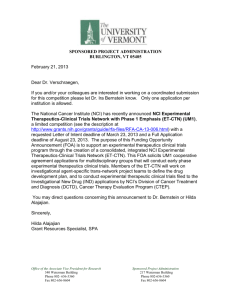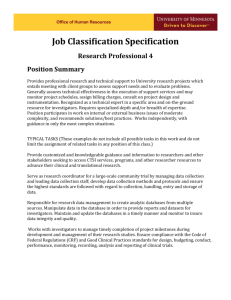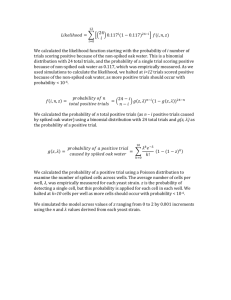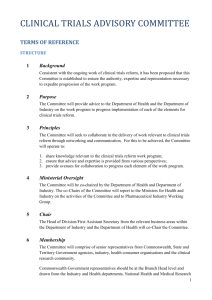NeuroNEXT Clinical Site Capabilities
advertisement
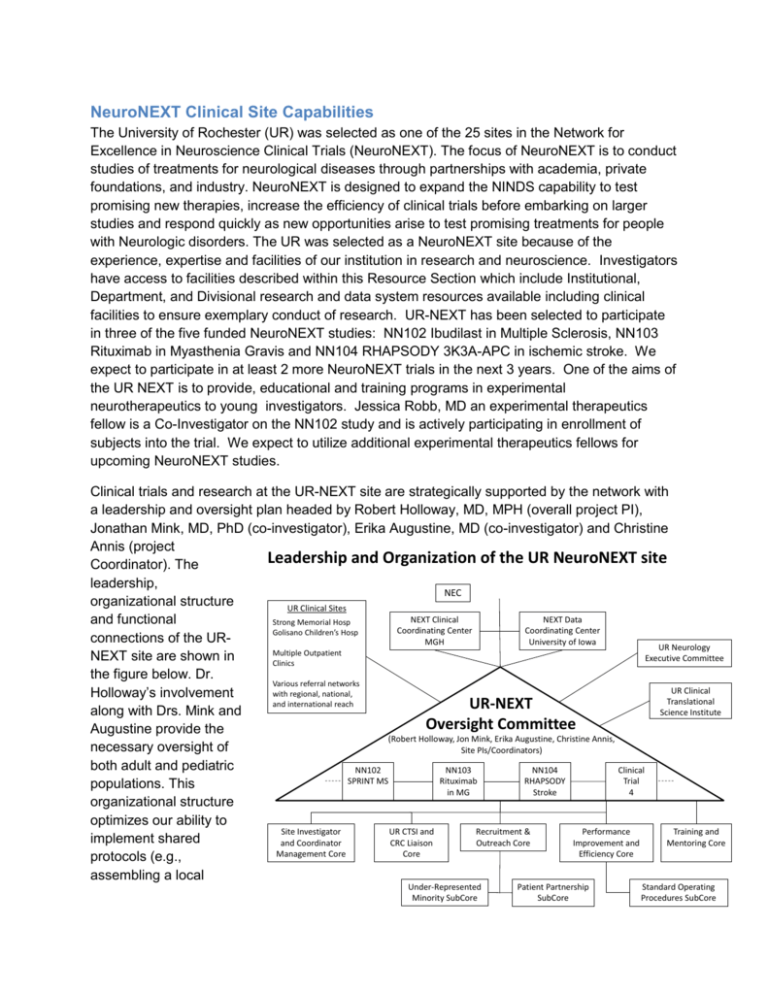
NeuroNEXT Clinical Site Capabilities The University of Rochester (UR) was selected as one of the 25 sites in the Network for Excellence in Neuroscience Clinical Trials (NeuroNEXT). The focus of NeuroNEXT is to conduct studies of treatments for neurological diseases through partnerships with academia, private foundations, and industry. NeuroNEXT is designed to expand the NINDS capability to test promising new therapies, increase the efficiency of clinical trials before embarking on larger studies and respond quickly as new opportunities arise to test promising treatments for people with Neurologic disorders. The UR was selected as a NeuroNEXT site because of the experience, expertise and facilities of our institution in research and neuroscience. Investigators have access to facilities described within this Resource Section which include Institutional, Department, and Divisional research and data system resources available including clinical facilities to ensure exemplary conduct of research. UR-NEXT has been selected to participate in three of the five funded NeuroNEXT studies: NN102 Ibudilast in Multiple Sclerosis, NN103 Rituximab in Myasthenia Gravis and NN104 RHAPSODY 3K3A-APC in ischemic stroke. We expect to participate in at least 2 more NeuroNEXT trials in the next 3 years. One of the aims of the UR NEXT is to provide, educational and training programs in experimental neurotherapeutics to young investigators. Jessica Robb, MD an experimental therapeutics fellow is a Co-Investigator on the NN102 study and is actively participating in enrollment of subjects into the trial. We expect to utilize additional experimental therapeutics fellows for upcoming NeuroNEXT studies. Clinical trials and research at the UR-NEXT site are strategically supported by the network with a leadership and oversight plan headed by Robert Holloway, MD, MPH (overall project PI), Jonathan Mink, MD, PhD (co-investigator), Erika Augustine, MD (co-investigator) and Christine Annis (project Leadership and Organization of the UR NeuroNEXT site Coordinator). The leadership, NEC organizational structure UR Clinical Sites NEXT Clinical NEXT Data and functional Strong Memorial Hosp Coordinating Center Coordinating Center Golisano Children’s Hosp connections of the URMGH University of Iowa UR Neurology Multiple Outpatient NEXT site are shown in Executive Committee Clinics the figure below. Dr. Various referral networks UR Clinical with regional, national, Holloway’s involvement Translational and international reach UR-NEXT along with Drs. Mink and Science Institute Oversight Committee Augustine provide the (Robert Holloway, Jon Mink, Erika Augustine, Christine Annis, necessary oversight of Site PIs/Coordinators) both adult and pediatric NN102 NN103 NN104 Clinical SPRINT MS Rituximab RHAPSODY Trial populations. This in MG Stroke 4 organizational structure optimizes our ability to Site Investigator UR CTSI and Recruitment & Performance Training and implement shared and Coordinator CRC Liaison Outreach Core Improvement and Mentoring Core Management Core Core Efficiency Core protocols (e.g., assembling a local Under-Represented Minority SubCore Patient Partnership SubCore Standard Operating Procedures SubCore research team, establishing contractual agreements, obtaining IRB approval & informed consent, recruiting, treating, and following research participants according to the study protocols, and collecting and entering accurate, high quality data into the central web-based data management system), and achieve the desired characteristics of a clinical trial site. The UR-NEXT Oversight Committee has overall leadership and programmatic accountability of all UR-NEXT Site operations. A total of 8-10 faculty and staff constitute the committee. Robert Holloway, the UR-NEXT Overall Site PI, serves as the Chair of the UR-NEXT Oversight Committee. Additional members of the Oversight Committee include Jonathan Mink, Erika Augustine, Christine Annis, with membership of local site PIs and local site coordinators. The Oversight Committee meet monthly. Support Functions and Services Support for Network participation and on-site operations are be provided by several cores and service functions. The neurology research administration office provides administrative support) for the Oversight Committee, including minutes, schedules, and resources. The other 5 cores include 1) Site Investigator and Coordinator Management Core, 2) UR-NEXT CTSI/CRC Liaison Core, 3) Recruitment and Outreach Core, 4) Performance Improvement and Efficiency Core, and 5) Training and Mentoring Core. The Recruitment and Outreach Core has two subcores; 3a) Under-represented Minority Subcore and 3b) Patient Partnership Subcore whereas the Performance Improvement and Efficiency Core has a Standard Operating Procedures Subcore. The oversight of each of these cores and subcores provided by the key personnel of this proposal in combination with individuals who have overlapping and synergistic Departmental or Institutional roles. The UR-NEXT CTSI/CRC Liaison Core takes advantage of several senior faculty members with overlapping functions and leadership positions within the UR-CTSI. These faculty include Drs. Robert Holloway, Robert Gross, Karl Kieburtz, and Giovanni Schifitto. Special Expertise and Unique Strengths of the UR-NEXT Site Role and use of biomarkers and surrogate endpoints. Many faculty are involved with various study design and interpretation challenges involving biomarkers as a potential marker of therapeutic activity. These have included developing standards for use of radiopharmaceuticals in clinical trials of Parkinson’s disease and the role and use of clinical biomarkers at trial endpoints. Clinical trial endpoints and outcome measurement. Several faculty have become leading authorities in the field of clinical trial endpoints and outcome measurement dealing with a variety of diseases including Parkinson’s disease, Huntington’s disease, muscular dystrophies, and stroke. These faculty have developed new multi-item scales, published critiques of prior measures, and incorporated disease measurement as a research interest within their therapeutic programs. Experience with academic consortia and research study groups. Many of our faculty are involved in regional, national and international research networks, including leadership roles such as overall PI and steering committee members (see table below). We are active participants in several child neurology research networks and have expertise in the conduct of multi-center investigation of rare diseases, muscle diseases, and movement disorders. Potential Investigators Involvement with Academic Consortia and Research Study Groups AIDS Clinical Trial Group Muscle Study Group Autism Treatment Network Batten Study Group Childhood Motor Disorders Study Group Consortium for Clinical Investigation of Neurologic Channelopathies Dystonia Study Group HIV Neuroimaging Consortium Huntington’s Study Group Lysosomal Disease Network Multiple Sclerosis-CORE Muscular Dystrophy Surveillance Tracking and Research Network Neuro-Ophthalmology Research Disease Investigator Consortium New York State Multiple Sclerosis Consortium NICHD Neonatal Research Network Parkinson Study Group PHIME European Consortium Rare Disease Clinical Research Network Tourette Syndrome Study Group Upstate New York DBS Consortium Data Safety Monitoring Board experience. Eleven of our potential co-investigators have experience as either a Chair or member of a Data Safety Monitoring Board (DSMB). The roles and responsibilities of DSMB members are becoming more complex as more trials use an adaptive framework and novel designs. Experimental therapeutics training. The majority of the mid-level and senior faculty at our site have experience in education and mentorship of fellows and junior faculty in experimental therapeutics. Available educational material and resources can be made available to the Network. Focusing on cost-effective targets. Several of our faculty have expertise in the methods to evaluate the cost-effectiveness of interventions for neurological conditions. These methods will be increasingly useful to estimate the impact and cost-effectiveness of various targets earlier in therapeutic development to not only address whether a treatment will be effective, but costeffective under varying assumptions of efficacy and cost. Telemedicine for remote assessments. The technology and acquired skills are being developed to perform remote clinical trial assessments, using agreed-upon standards and the proper establishment of reliability and validity. In the first application of this, telemedicine will be implemented as a key feature of the first-ever RCT for juvenile Batten Disease. This approach has great promise in providing clinical trial access to individuals with rare diseases, whose physical condition and/or geographic location may preclude easy travel to a central research site. Dr. Biglan is currently developing methods to perform remote assessments of patients with Parkinson’s disease in outpatient settings. Ethical issues in high-risk studies and conflicts of interest. In collaboration with investigators from the University of Michigan, Dr. Holloway is studying why research participants with neurodegenerative illnesses participate in clinical trials with invasive interventions (e.g., sham neurosurgery trials). By better understanding how research participants make decisions regarding participation in such clinical trials, the informed consent process can be improved. Neuropsychological expertise. Our neuropsychologists are experienced in design and application of cognitive measures for clinical research with a broad range of conditions including neurodegenerative diseases in children and adults, epilepsy, movement disorders, and stroke. They serve as site investigators and site neuropsychologists for multi-center clinical trials and all have their own independent research programs investigating aspects of cognition, in addition to psychosocial and quality of life aspects of neurological conditions.


